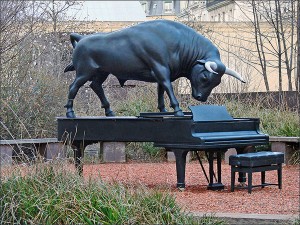Major art event opens in Ottawa: Sakahàn

“A Peak in Darien,” detail of an installation by New Zealand artist Michael Parekowhai at Musee du Quai Branly, Paris. Parekowhai is one of many indigenous artists represented in the exhibit “Sakahan” opening Friday, May 17, at the National Gallery of Canada. Photo: dalbera, Creative Commons, some rights reserved
Here’s the blurb, from a National Gallery webpage on Sakahàn:
This summer, the National Gallery of Canada is staging one of the most ambitious contemporary art exhibitions in its history. With installations filling both floors of our special exhibition spaces as well as our contemporary art galleries—not to mention several public spaces inside and outside the Gallery—Sakahàn: International Indigenous Art is Canada’s must-see exhibition this year.
I actually encountered advance “buzz” about this show back in February, but it seemed too soon to put in on station blogs.
Early mentions were quite positive. Sakahàn would be the “…largest exhibition of contemporary indigenous art ever held in the world, according to curators”, an event that could reduce the distance between aboriginal art and high art, or so some hoped.
Well, time sure flies and now it’s here. This major summer exhibit opens Friday, May 17th. (The last day will be Monday Sept 2nd).
Ottawa Citizen “Big Beat” blogger Peter Simpson calls Sakahàn “a spectacular show”
The massive exhibition of indigenous art — the largest ever held anywhere, the National Gallery says — is a sweeping look at the work from Mexico to Norway to New Zealand and, of course, Canada. It sprawls throughout the gallery, and out onto the grounds. By the time all of its components are up and running it’ll have satellite exhibitions in the Ottawa Art Gallery, SAW Gallery, Carleton University Art Gallery, the Museum of Civilization, the National Arts Centre and in other Ottawa venues. Like a wave of colonizing settlers, the art in Sakahàn has taken over the land.
In a separate post Simpson hints at a huge “surprise” that will also catch the eye of anyone in the vicinity of the National Gallery – a beautiful building with a spectacular view any time of year.
Now I’ll put my foot in my mouth and ask about the pros and cons of lumping art in this manner.
Pro: without a group focus, most of this art might not be seen, or would be seen in scattered isolation.
Pro: native/aboriginal people do have much in common and can benefit from greater networking and linkage
Pro: non-natives (like me) can learn more by being exposed to a broad range of aboriginal art and issues gathered in one place
(What other “pro” points have I overlooked?)
Con: Should diverse, individual artists be lumped this way? Is doing that a blessing, or a curse?
This is a question I often ponder, even though asking it comes across as impolite, or worse.
But, seriously: what makes native or aboriginal art native or aboriginal? Is it the nature of the art? The ethnicity of the artist? The larger native culture that decides who’s in and who’s out? All of the above?
What defines this? Should it be defined?
I’m from Hawaii where many, many races co-existing and (so-called) intermarriage is the norm. Hawaii is proud of being a rainbow culture. Even so, I often have the same (equally impolite) questions there.
For example, when someone who is 1/32nd Hawaiian self-identifies as a Hawaiian artist, well, at that level of genetic code, couldn’t a non-Hawaiian who also identifies with native culture be equally “Hawaiian”? How much of this is about so-called blood, and how much of it is about culture?
The same question comes up in similar ways over things like gender, or age.
Is there such a thing as “women writers”, for example? Or are all writers just writers?
At the Oscars, why are there separate categories for actress and actor? Is acting a gender specific activity? Or are we simply better able ( more accustomed) to compare by gender?
At the Olympics, were minimum ages for sports like women’s gymnastics adopted to protect children, or because a slip of pre-adolescent can flip and contort in ways a 16-year-old woman can’t?
Now I’ve wandered far afield from the original question. But here we are!
When do you find grouping by category helpful? When do you think it hurts?
And putting all that aside, if you’re in Ottawa this summer, consider dropping in on Sakahàn. It sounds very worthwhile.
Tags: art, canada, National gallery of Art, native culture, native issues, Peter Simpson, Sakahàn, tourism, travel






